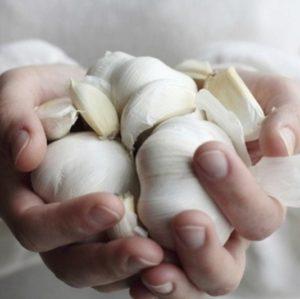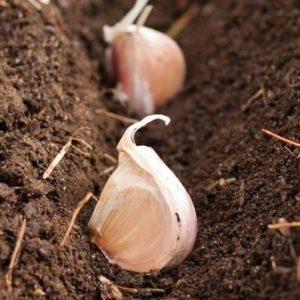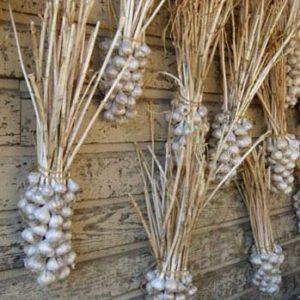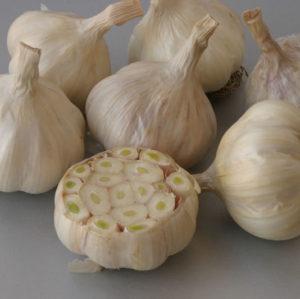Secrets of Effective Home and Commercial Garlic Growing as a Business
Garlic is one of the most popular crops for cultivation among summer residents and gardeners. And professional gardeners completely turn this process into a profitable business. In this article, we will analyze in detail the subtleties and secrets of growing garlic, and also tell you in detail how you can start a business on its sales from scratch.
The content of the article
Winter and spring varieties of garlic
What does the structure of garlic look like? It consists of a bulb (it is also a head), a bottom (a short stem coming from the bulb), leaves, shooters, inflorescences, bulbs (or air bulbs, they are formed in an inflorescence in an amount of 2 to 500 or more).
Garlic is divided into winter and spring according to the planting time. Winter varieties are planted in autumn and spring varieties in spring. Consider their features and differences between themselves.
Winter varieties:
- garlic onions are larger and more even, contain fewer cloves - no more than 9 in one head. They are located evenly around the central rod;
- more productive;
- the growing season is shorter;
- shooters (with a few exceptions) - throws out arrows with air bulbs;
- not stored for long, it is better to use fresh or preserve.
Spring varieties:
- there is no central rod, there are more teeth, they are smaller, located in a spiral, smaller inside, larger to the edge;
- less productive;
- the growing season is longer;
- non-shooting;
- stored until the next harvest.
You can test the varieties yourself by choosing a few you like and growing them. You can also buy from friends. There are always gardeners who succeed in growing garlic wonderfully well. A few bulbs are enough for planting.
Varieties adapted for planting in the middle lane:
- Winter crops: Podmoskovny, Dobrynya, Jubilee Gribovsky.
- Spring: Yelenovsky, Sochi-56, Gulliver.
 Before planting, the teeth need to be sorted out and make sure that they:
Before planting, the teeth need to be sorted out and make sure that they:
- dry, strong (soft discard);
- there is no infection on them;
- they are large.
Plant the garlic with the base down, with the sharp tip up. Separate the cloves from the garlic head carefully, without damaging the base, otherwise they will not grow.
Opinions differ regarding pre-planting treatment. If you have chosen a planting material, in the properties of which you are sure, you can skip this step.It is better to treat an unfamiliar with a fungicide.
Optimal planting time
The time for boarding depends on varieties, weather conditions and soil characteristics.
Planting garlic before winter - timing
It is recommended to plant winter crops 20-25 days before the soil freezes.
Unpredictable weather can cause garlic to become damp or freeze... The likelihood of getting a good harvest is increased if planted in two approaches, in late September and mid-October. They are planted to a depth of 6–7 cm. In regions with severe winters, so that the garlic does not freeze, the holes are deepened to 10 cm.
Spring planting in open ground
Spring is planted closer to the end of April, and even earlier on sunny beds.They do this when the snow has already melted, into slightly moist soil with an established temperature of at least 5 degrees. They are planted to a depth of 3-5 cm.
Growing and caring for garlic outdoors
Let's consider step by step how to properly grow and care for garlic.
The choice of soil for planting
The principle of choosing a landing site - sun or partial shade. The soil should be crumbly, well-drained.
Important! Garlic loves the sun. The more it is, the more abundant the harvest.
Garlic prefers neutral soil. The acidity is reduced with dolomite flour or slaked lime, and increased with the help of ash.
Winter varieties like airy sandy loam. Spring prefer slightly acidic loam.
Garlic loves to "move" from place to place. If you plant it on the same bed more than once, it starts to hurt and wither. The earth is allowed to rest for 3-4 years (if infected with rot - 6-7 years) and only then is it planted again.
It is important to know what grew at the planting site before the garlic and what grows next to it:
- plant well after legumes, cabbage, melons, cucumbers, lettuce;
- bad - after onions, potatoes, tomatoes;
- gets along with lettuce, beans, tomatoes, parsnips and kohlrabi;
- does not like the neighborhood with radishes, beets, carrots, asparagus and spinach.
Reference. Roses protect garlic from aphids.
Preparing the garden for planting garlic
If the land is not developed, make high beds, at least 25 cm of loose, organic-rich structural soil. In the first years, it is better to loosen with a pitchfork without turning the layer, add organic matter only from above and entrust the loosening of the soil to living organisms, weed and green manure roots.
Attention! You cannot fertilize a garden with manure for garlic.
 Garlic is bad in beds fertilized with fresh manure. The ground under it should not be too dense, so as not to push to the surface. But too soft too - it can pull down, and the heads will grow small.
Garlic is bad in beds fertilized with fresh manure. The ground under it should not be too dense, so as not to push to the surface. But too soft too - it can pull down, and the heads will grow small.
Caring owners prepare the beds in advance.
Under the spring: one to two weeks before planting, they dig up the ground, making sure that there are no wheatgrass and other rhizome weeds, lay a layer of compost about 10 cm thick and cover with foil. On the day of planting, the soil is loosened, grooves are prepared and planted.
For winter: in the spring it is better to plant peas or another crop, after which garlic grows better. Pea greens can not be removed from the garden, but left as an organic fertilizer. Cover the bed with compost, etc., before planting.
Landing rules
Standard: 25–45 cm between rows, 10–20 cm between plants of large, winter crops, 7–10 cm for spring crops. Depends on the variety - you can calculate by looking at the size of the ripe heads in the description.
Attention! Mandatory mulching and loosening of the soil - this will keep moisture and oxygen in the ground.
For mulching, hay, grass, sawdust or straw are used. Cover the top of the winter garlic beds with compost. Garlic will not be afraid of harsh winters under mulch from dry leaves in 5 cm. But before germination, the leaves must be removed, otherwise it will be difficult to fight the weeds.
Caring for garlic after planting
After planting, such stages follow as loosening, weeding, watering, mulching with organic matter.
During the phase of the third leaf, mulch with rotted manure and water abundantly, loosen the soil for a couple of days. Garlic cannot grow without oxygen.
Most of the regrown arrows are removed as soon as a loop appears. Inflorescences with large cotyledons are left for growing bulbs.
Fertilizing and feeding
They feed him with organic matter. She is regularly mulched plantings - the first time after 2 weeks, then a month later, the last - 2-3 weeks before harvesting.
If there is not enough organic matter, potassium salts and superphosphates are introduced into the grooves next to the plantings. Additionally, you can sprinkle the plantings with plaster.
Important! Garlic needs less nitrogen and more potassium and phosphorus.
Watering
Held once a week if there is no precipitation.
As a rule, there is enough rain - especially for plants planted in partial shade.
Garlic does not like moisture, but heat is also dangerous for it. If the leaves droop from lack of moisture, a rich harvest will not work.
Common diseases and pests
 The most common diseases:
The most common diseases:
- Rot of the bottom (or fusarium). Signs of damage: yellowing of leaves, death of roots.
- Bacterial rot. Signs of damage: the formation of brown ulcers on the teeth, which become glassy, "frostbitten".
- Downy mildew (or downy mildew). Signs of damage: the appearance of a gray bloom on the leaves and arrows, drying of the affected parts of the plant, immature bulbs.
Of the insect pests, onion flies and their larvae, which feed on the tissue of the bulbs, cause the greatest harm.
By selecting and planting no more than once every 3-4 years, pesticides can be eliminated, and ASC can be used for prevention.
Harvesting
 Harvested from garlic in dry, sunny weather. If such is not foreseen, a canopy of film is built, and the earth is raked off the bulbs.
Harvested from garlic in dry, sunny weather. If such is not foreseen, a canopy of film is built, and the earth is raked off the bulbs.
Winter garlic collected after the arrows are straightened.
Spring - when the upper leaves turn yellow and the lower leaves begin to adhere to the soil.
Ripening can be extended by two to three weeks if the leaves are tied in a knot. The bulb will weigh much more.
Attention! If the neck has not matured, moisture will enter through it - this will lead to rotting.
To check the ripening of the crop, a couple of heads are dug:
- first, the bulb is young;
- then the teeth begin to take shape, they can already be divided;
- then the husk dries up, the bulb is covered with a thin shell without breaks;
- a week later, bulbs appear with a rupture of the shell and the decay of overripe cloves;
- garlic should be removed at the stage of dry scales without rupture.
Storage
 Thanks to phytoncides, garlic is resistant to diseases, pests and various temperatures. Nevertheless, there are some rules for its storage.
Thanks to phytoncides, garlic is resistant to diseases, pests and various temperatures. Nevertheless, there are some rules for its storage.
After harvesting, the garlic is dried in the sun in a ventilated place (periodically you need to shake it). Drying time is 10-15 days. Leaves and roots are not cut off immediately - they will provide nutrients for the ripening of garlic. It is best to cut them off after drying. An indicator that the garlic is well dried is dry husk and bottom.
After drying, it is sorted out and left in a dry, ventilated room. You can store it at any temperature above 0, the humidity should be no higher than 80%, otherwise the teeth will rot and begin to rot.
Garlic is stored in nets, cardboard boxes and wooden crates - loose or weaving with leaves into braids. Old nylon stockings or pillowcases are suitable for hanging.
Winter garlic does not last long. Already in the summer it is used in homemade preparations. You can just peel and cover with oil or vinegar.
Important! Planting material requires special storage. It must be protected from extremes and medium temperatures, otherwise it will begin to germinate. Either stable heat (18-25 degrees) or stable cold (1-5 degrees).
How to grow garlic from bulbs?
 Garlic doesn't have seeds. Garlic is a culture with a three-year cycle: from a bulb to a single-tooth, then to a clove, and from a clove again the same bulb.
Garlic doesn't have seeds. Garlic is a culture with a three-year cycle: from a bulb to a single-tooth, then to a clove, and from a clove again the same bulb.
The arrows are cut as soon as the outer wrap holding the bulbs begins to burst. They are tied in bunches and hung in a cool shaded place to ripen.
The material is calibrated by taking formed, dense bulbs with a diameter of 3 mm or more.
When sowing bulbs 5 × 5 cm per 1 sq. m will grow almost 400 one-tooth, they are enough for a garden bed of 10 sq. m. When planting 20 × 20 cm, heads of 100 g or more will grow.
With the help of seed drills, they sow to a depth of 2–4 cm at the same time as winter garlic.
After sowing, the beds are mulched with humus or compost in a layer of 8–10 cm.
Growing bulbs in the second year will reduce the cost of seed. Plants from seedlings are more viable and productive.
How and what to feed garlic after winter so that it does not turn yellow
If the leaves turn yellow, then the root system is damaged. This may be due to increased acidity of the soil, lack of nitrogen, potassium, watering, as well as disease or pest damage.
The problem is solved by introducing insecticide and fertilizing, loosening the soil and increasing watering.
Why garlic gets smaller and how you can avoid it
Garlic is a culture that loses its qualities over the years, up to degeneration. It is necessary to heal the planting material annually by a quarter, or better by a third. This will have a beneficial effect on the quality, rejuvenation and health of plants.
Growing garlic as a business
 When the technology of growing garlic is well studied, you can think about making a profit.
When the technology of growing garlic is well studied, you can think about making a profit.
As an industrial crop, garlic has advantages:
- the culture is relatively unpretentious;
- grows in open ground;
- does not require complex agrotechnical work;
- the costs are minimal, a large start-up capital is not needed;
- is in constant demand, it is easy to find distribution channels.
The profitability of growing garlic
Let's figure out how to calculate the ability to grow garlic on a large scale.
Attention! The result directly depends on the size of the plot, the selected variety, etc. Average figures are used in the calculation.
| Cost item | 1 are | 1 hectare |
| check in | not needed, if you are not going to cooperate with large companies, you can operate within the framework of private household plots (personal subsidiary plots); | Individual entrepreneur, LLC or a peasant farm - 20,000 rubles |
| Land lease | not required | 2,000 rubles per hectare |
| Purchase of planting material | if necessary - 3 750 rubles | 37,500 rubles |
| Fertilizers | 150 rubles | 15,000 rubles |
| Equipment rental | not necessary | 75,000 rubles |
| Buying garden tools | may not be needed, maximum 30,000 rubles | 30,000 rubles |
| Salary for employees and accountant | need not | 40,000 rubles |
| Storage room rental | not necessary | 15,000 rubles |
| Total: | maximum costs - 33,900 rubles. | costs - 234 500 rubles |
Depending on the variety, you can get from 10 to 50 tons of crops per hectare. A well-chosen variety will increase the yield by 5 times.
Business payback
 Large volumes cannot be sold to small resellers and sold on the market by yourself, you need to conclude an agreement with a large wholesaler. It is reliable, but not always profitable (the wholesale price will be 35-50 rubles per kg, or 35,000-50,000 rubles per ton). This is due to the fact that the intermediary assumes all the risks of further storage and sale.
Large volumes cannot be sold to small resellers and sold on the market by yourself, you need to conclude an agreement with a large wholesaler. It is reliable, but not always profitable (the wholesale price will be 35-50 rubles per kg, or 35,000-50,000 rubles per ton). This is due to the fact that the intermediary assumes all the risks of further storage and sale.
Will increase the wholesale price of a nearby cannery or other food processing enterprise - for example, a chain of restaurants.
By selling the harvest from 1 hectare at the minimum wholesale price, during the season you can not only recoup the costs, but also get at least 115,500 rubles of profit.
Harvest from 1 are easy to sell to small grocery stores. The selling price will be higher than the wholesale price, but slightly, 50-60 rubles per kg. If you sell yourself on the market, it will increase to 110–140 rubles, but in this case, the risks increase.
If it is necessary to purchase inventory and seed, the minimum income from sales (5,000 rubles for a harvest of 100 kg per one hundred square meters) is not enough to recoup the costs. Profitability will appear on a plot of 7 acres or more.
Where to start a garlic business?
First you need to determine your capabilities and draw up a business plan.
Better to start with a small area and manual labor. If the business pays off - you can expand the area and rent / buy equipment.
Keep in mind that a large area is more difficult to handle. Find sales channels first and only then expand your landing.
Tips & Tricks
Growing crops can be profitable, albeit labor intensive. The main thing is to adequately assess your capabilities, remember about the alternation of garlic with other crops, correctly select varieties, engage in health improvement and take care of plantings.
Conclusion
Garlic is indispensable in cooking.For centuries, people have been using the plant as part of potions and ointments to treat migraines, poisonous bites, burns, wounds, pain relief, strengthen the strength and protective properties of the body. Garlic benefits the garden, its bactericidal properties protect plants planted nearby from infection.
Thanks to the variety of varieties, it is possible to grow garlic in almost all climatic zones. With minimal investment, this activity will make it profitable as well.